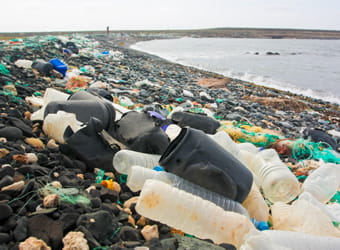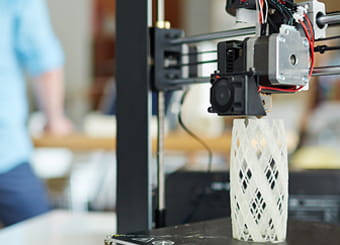There’s nothing more innocuous than a single sheet of cling film, wrapped around your chicken mayo sandwich. But add up all those sandwiches and suddenly you’re looking at a picnic of cataclysmic proportions. Professor Jan Zalasiewicz of Leicester University has revealed that if all the plastic waste produced to date were converted to cling film, it would be enough to not only wrap billions of sandwiches and leftovers, but to wrap the entire planet as a whole! Welcome to the Anthropocene – a new geological epoch that recognises the mark that humans have made on Earth.
The concerning thing is, plastic waste is only one facet of a much larger set of interconnected impacts arising from our civilisation. With an estimated 16 million tons of plastic added to our oceans annually, combined with civilisation’s other waste products dispersing into the environment, we could face everything from unpredictable climate change to mass extinction.
Some would argue that the end of the world is nigh. Most would say we’re to blame for it, regardless of where your apocalyptic leanings lie.
The term ‘Anthropocene’ was coined by Nobel Prize winning scientist Paul Crutzen in 2000, asserting that the predominance of earth’s major natural systems over billions of years has been overhauled by human activity in an infinitesimal period of time. Through our insatiable appetite for fossil fuels and other finite resources, humanity’s impact has started to significantly alter the geological patterns and compositions of our habitats and atmosphere in a measurable way.
Is it really possible that the Earth, which managed to outlive the ice age and mass meteor destruction, could be derailed by the human species which, in relative terms, has just joined the geological time scale? Many scientists would say yes. Is this the end of life as we know it? Or is this another tale of creative adaptation? You decide.
A change in the climates of the climate
Pulitzer Prize winning journalist and best-selling author, Thomas Friedman, argues that we are in the middle of not one but three simultaneous ‘climate changes’: one environmental, one economic, and one technological.
“First, there is climate change, and the knowledge that the time where we could fix any environmental problem either now or later has shifted to needing to be fixed now. Next, the climate of globalisation has changed. The world is no longer just interconnected; it is now interdependent. Lastly, the climate of technology has changed. People are adapting to a world with cloud computing, artificial intelligence and big data. These changes have created a business environment where you can analyse, optimise, prophesise, customise and digitise anything,” Friedman says.
If we want to discern the times, we have to start by understanding that we have no time. There is a sense of urgency underpinning the Anthropocene, where we no longer have the luxury of ‘later’. If in the past you could delay any climate or environmental problem for later, today, there is no later. 'Later' will sadly be too late.
The key is to study and consider these three climate changes and see how we can get the most out of these changes, while cushioning the worst. How can we utilise technology to build agile businesses and mitigate environmental risks? How can AI stay one step ahead of our anticipated pitfalls and outwit our demise? And, if the collective actions by humans have the capacity to bring actual change to the world, as the Anthropocene suggests, how can we turn the tables and use that ability for the good?
Interpreting and deploying these factors within the context of globalisation will determine how well we navigate through an uncertain and risky future. Our next move is critical and we have to think of a good one, and fast!
Rolling out renewable’s red carpet
 Engineer and inventor, Elon Musk, would say it’s not only a matter of asking the right questions. It’s also a matter of time. Says Tesla's founder:
Engineer and inventor, Elon Musk, would say it’s not only a matter of asking the right questions. It’s also a matter of time. Says Tesla's founder:
“I look at the future from the standpoint of probabilities. It’s like a branching stream of probabilities, and there are actions that we can take that affect those probabilities or that accelerate one thing or slow down another thing… If you don’t have sustainable energy, it means you have unsustainable energy. Eventually you will run out, and the laws of economics will drive civilisation towards sustainable energy, inevitably.”
Musk has always insisted that Tesla’s ultimate purpose isn’t to build cars – it’s to help the world to transition away from reliance on fossil fuels and toward the embrace of sustainable energy sources. The degree to which any of his inventions accelerate the advent of sustainable energy, faster than it would otherwise occur, is the degree to which that invention will hold value down the line.
Renewable energy is at a tipping point. Wind, solar and battery energy are seeing an exponential fall in cost and an exponential rise in the uptake of these technologies.
In December, Tesla officially inaugurated the world’s largest lithium ion battery in Australia, making good on CEO Elon Musk’s promise to deliver a solution to power outages in the state within 100 days of signing a contract. Tesla’s 100-megawatt battery, located at a wind power plant north of Adelaide, can independently power up to 30 000 homes for an hour.
As we wait for major breakthroughs and game changers such as the widespread use of solar power, second generation biofuels, and potentially transformative technologies like commercial nuclear fusion energy, Musk would be the first to agree: when it comes to renewable and other alternative energy sources, we’re only getting started.
All hands on deck
But technological advancement can only be carried so far on the shoulders of a few individuals.
"People are mistaken when they think that technology just automatically improves. It does not automatically improve. It only improves if a lot of people work very hard to make it better and actually, I think it will, by itself, degrade,” Musk adds. And, if it does degrade, where does that leave us?
Ultimately: The Anthropocene calls for society to adopt an all hands on deck approach to its monumental mission. Every facet of civil society – business, non-profits, academic institutions, governments, consumers, and more – needs to be involved in the conversation. There is no later or tomorrow or maybe next year. The time is now. We need to reimagine design that is comprehensive, holistic, and integrative enough to offer robust solutions and help humanity to not just survive but also thrive on a complex Anthropocene landscape.
Beyond buildings, we need to design for sustainable precincts – entire urban ecosystems that merge sustainable buildings, urban design, infrastructure and socio economic and community needs into one organic system. Every element contributing to the flow and functionality of that ecosystem must work together to optimise its overall liveability and green design.
Imagine, for example, if every new building required a transportation plan so that the inhabitants could move between their home, work and other locations without the consumption of fossil fuel. Or, consider that by 2025, new buildings will generate 90 per cent of the power that they consume.
The implications of such designs would roll out like ripples over every sphere of city planning, rendering major shifts in the way we invest, build and envision a future-ready society.
The Anthropocene is indeed as elusive and daunting as the word itself. The global and interconnected nature of our problems could leave us wide-eyed and paralysed to act. But: The sooner we grasp the magnitude of the problem, the sooner we can spring to intelligent action. And get everyone to collaborate for change. Is it too late for that? Some may say so. On the other hand, let’s not sit around, waiting to find out.
We are now in the Anthropocene. Time to make your next move, humans.








 But all that is changing now. The benefits of high-end engineering technologies are now at anyone’s fingertips. The same inventions that took large budgets and high-tech laboratories can be performed with a personal laptop in someone’s living room. We buy drones as birthday presents.
But all that is changing now. The benefits of high-end engineering technologies are now at anyone’s fingertips. The same inventions that took large budgets and high-tech laboratories can be performed with a personal laptop in someone’s living room. We buy drones as birthday presents.